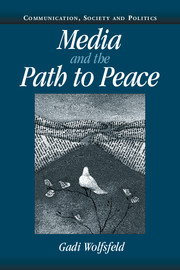Book contents
- Frontmatter
- Contents
- Acknowledgements
- Introduction
- 1 Building theory
- 2 The initial stages of Oslo
- 3 The Israeli media and the debate over Oslo
- 4 The Palestinians and the Israeli media
- 5 The media and the Israel–Jordan peace process
- 6 The media and the struggle for peace in Northern Ireland
- 7 The collapse of Oslo and the return to violence
- Conclusion
- Methodological appendix
- References
- Index
4 - The Palestinians and the Israeli media
Published online by Cambridge University Press: 22 September 2009
- Frontmatter
- Contents
- Acknowledgements
- Introduction
- 1 Building theory
- 2 The initial stages of Oslo
- 3 The Israeli media and the debate over Oslo
- 4 The Palestinians and the Israeli media
- 5 The media and the Israel–Jordan peace process
- 6 The media and the struggle for peace in Northern Ireland
- 7 The collapse of Oslo and the return to violence
- Conclusion
- Methodological appendix
- References
- Index
Summary
The British comedy group Monty Python used to perform a comedy sketch about a group of elderly gentleman sitting around a coffee table talking about how difficult their childhood had been. The first talked about living with his family in a small shack in the middle of the woods. The second laughs and says something like: “A shack, we only wish we had a shack, we all lived in one room the size of a closet.” The third laughs yet again: “A closet, why we dreamed about living in a closet, we had to live in a shoebox.” Well, when it comes to the political actors and their relationship with the Hebrew news media, we've now come to the shoebox.
The Israeli press has always related to the Palestinians as enemies. As in any other country, the news slot reserved for enemies centers on the amount of threat they pose and on what the country is doing to minimize that threat. The news media also serve as an important forum for expressing public hatred towards enemies and for reflecting and reinforcing common stereotypes. Sources or journalists who are suspected of sympathizing with enemies are likely to come under intensive attack. The denigration of CNN reporter Peter Arnett, who was stationed in Iraq during the Gulf War, is a well-known example of this phenomenon.
Nevertheless, the political environment has an important influence on the negativity of enemy images. The news media become the most ethnocentric in the midst of violent conflict.
- Type
- Chapter
- Information
- Media and the Path to Peace , pp. 104 - 136Publisher: Cambridge University PressPrint publication year: 2004



